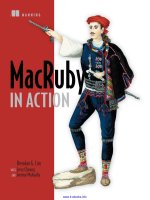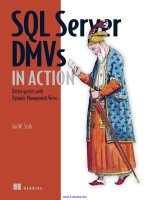r in action
Bạn đang xem bản rút gọn của tài liệu. Xem và tải ngay bản đầy đủ của tài liệu tại đây (15.28 MB, 474 trang )
MANNING
Robert I. Kabacoff
Data analysis and graphics with R
IN ACTION
www.it-ebooks.info
R in Action
www.it-ebooks.info
www.it-ebooks.info
R in Action
Data analysis and graphics with R
ROBERT I. KABACOFF
MANNING
Shelter Island
www.it-ebooks.info
For online information and ordering of this and other Manning books, please visit
www.manning.com. The publisher offers discounts on this book when ordered in quantity.
For more information, please contact
Special Sales Department
Manning Publications Co.
20 Baldwin Road
PO Box 261
Shelter Island, NY 11964 Email:
©2011 by Manning Publications Co. All rights reserved.
No part of this publication may be reproduced, stored in a retrieval system, or transmitted, in
any form or by means electronic, mechanical, photocopying, or otherwise, without prior written
permission of the publisher.
Many of the designations used by manufacturers and sellers to distinguish their products are
claimed as trademarks. Where those designations appear in the book, and Manning
Publications was aware of a trademark claim, the designations have been printed in initial caps
or all caps.
Recognizing the importance of preserving what has been written, it is Manning’s policy to have
the books we publish printed on acid-free paper, and we exert our best efforts to that end.
Recognizing also our responsibility to conserve the resources of our planet, Manning books
are printed on paper that is at least 15 percent recycled and processed without the use of
elemental chlorine.
Manning Publications Co. Development editor: Sebastian Stirling
20 Baldwin Road Copyeditor: Liz Welch
PO Box 261 Typesetter: Composure Graphics
Shelter Island, NY 11964 Cover designer: Marija Tudor
ISBN: 9781935182399
Printed in the United States of America
1 2 3 4 5 6 7 8 9 10 MAL 16 15 14 13 12 11
www.it-ebooks.info
v
brief contents
Part I Getting started 1
1
■
Introduction to R 3
2
■
Creating a dataset 21
3
■
Getting started with graphs 45
4
■
Basic data management 73
5
■
Advanced data management 91
Part II Basic methods 117
6
■
Basic graphs 119
7
■
Basic statistics 141
Part III Intermediate methods 171
8
■
Regression 173
9
■
Analysis of variance 219
10
■
Power analysis 246
11
■
Intermediate graphs 263
12
■
Resampling statistics and bootstrapping 291
www.it-ebooks.info
vi BRIEF CONTENTS
Part IV Advanced methods 311
13
■
Generalized linear models 313
14
■
Principal components and factor analysis 331
15
■
Advanced methods for missing data 352
16
■
Advanced graphics 373
www.it-ebooks.info
vii
contents
preface xv
acknowledgments xvii
about this book xix
about the cover illustration xxiv
Part I Getting started 1
1
Introduction to R 3
1.1 Why use R? 5
1.2 Obtaining and installing R 7
1.3 Working with R 7
Getting started 8
■
Getting help 11
■
The workspace 11
Input and output 13
1.4 Packages 14
What are packages? 15
■
Installing a package 16
Loading a package 16
■
Learning about a package 16
1.5 Batch processing 17
1.6 Using output as input—reusing results 18
1.7 Working with large datasets 18
www.it-ebooks.info
viii CONTENTS
1.8 Working through an example 18
1.9 Summary 20
2
Creating a dataset 21
2.1 Understanding datasets 22
2.2 Data structures 23
Vectors 24
■
Matrices 24
■
Arrays 26
■
Data frames 27
Factors 30
■
Lists 32
2.3 Data input 33
Entering data from the keyboard 34
■
Importing data from a delimited text
file 35
■
Importing data from Excel 36
■
Importing data from XML 37
Webscraping 37
■
Importing data from SPSS 38
■
Importing data from SAS 38
Importing data from Stata 38
■
Importing data from netCDF 39
Importing data from HDF5 39
■
Accessing database management systems
(DBMSs) 39
■
Importing data via Stat/Transfer 41
2.4 Annotating datasets 42
Variable labels 42
■
Value labels 42
2.5 Useful functions for working with data objects 42
2.6 Summary 43
3
Getting started with graphs 45
3.1 Working with graphs 46
3.2 A simple example 48
3.3 Graphical parameters 49
Symbols and lines 50
■
Colors 52
■
Text characteristics 53
Graph and margin dimensions 54
3.4 Adding text, customized axes, and legends 56
Titles 57
■
Axes 57
■
Reference lines 60
■
Legend 60
Text annotations 62
3.5 Combining graphs 65
Creating a figure arrangement with fine control 69
3.6 Summary 71
4
Basic data management 73
4.1 A working example 73
4.2 Creating new variables 75
4.3 Recoding variables 76
www.it-ebooks.info
CONTENTS ix
4.4 Renaming variables 78
4.5 Missing values 79
Recoding values to missing 80
■
Excluding missing values from analyses 80
4.6 Date values 81
Converting dates to character variables 83
■
Going further 83
4.7 Type conversions 83
4.8 Sorting data 84
4.9 Merging datasets 85
Adding columns 85
■
Adding rows 85
4.10 Subsetting datasets 86
Selecting (keeping) variables 86
■
Excluding (dropping) variables 86
Selecting observations 87
■
The subset() function 88
■
Random samples 89
4.11 Using SQL statements to manipulate data frames 89
4.12 Summary 90
5
Advanced data management 91
5.1 A data management challenge 92
5.2 Numerical and character functions 93
Mathematical functions 93
■
Statistical functions 94
■
Probability functions 96
Character functions 99
■
Other useful functions 101
■
Applying functions to
matrices and data frames 102
5.3 A solution for our data management challenge 103
5.4 Control flow 107
Repetition and looping 107
■
Conditional execution 108
5.5 User-written functions 109
5.6 Aggregation and restructuring 112
Transpose 112
■
Aggregating data 112
■
The reshape package 113
5.7 Summary 116
Part II Basic methods 117
6
Basic graphs 119
6.1 Bar plots 120
Simple bar plots 120
■
Stacked and grouped bar plots 121
■
Mean bar plots 122
Tweaking bar plots 123
■
Spinograms 124
6.2 Pie charts 125
6.3 Histograms 128
www.it-ebooks.info
x CONTENTS
6.4 Kernel density plots 130
6.5 Box plots 133
Using parallel box plots to compare groups 134
■
Violin plots 137
6.6 Dot plots 138
6.7 Summary 140
7
Basic statistics 141
7.1 Descriptive statistics 142
A menagerie of methods 142
■
Descriptive statistics by group 146
Visualizing results 149
7.2 Frequency and contingency tables 149
Generating frequency tables 150
■
Tests of independence 156
Measures of association 157
■
Visualizing results 158
Converting tables to flat files 158
7.3 Correlations 159
Types of correlations 160
■
Testing correlations for significance 162
Visualizing correlations 164
7.4 t-tests 164
Independent t-test 164
■
Dependent t-test 165
■
When there are more than two
groups 166
7.5 Nonparametric tests of group differences 166
Comparing two groups 166
■
Comparing more than two groups 168
7.6 Visualizing group differences 170
7.7 Summary 170
Part III Intermediate methods 171
8
Regression 173
8.1 The many faces of regression 174
Scenarios for using OLS regression 175
■
What you need to know 176
8.2 OLS regression 177
Fitting regression models with lm() 178
■
Simple linear regression 179
Polynomial regression 181
■
Multiple linear regression 184
Multiple linear regression with interactions 186
8.3 Regression diagnostics 188
A typical approach 189
■
An enhanced approach 192
■
Global validation of
linear model assumption 199
■
Multicollinearity 199
8.4 Unusual observations 200
Outliers 200
■
High leverage points 201
■
Influential observations 202
www.it-ebooks.info
CONTENTS xi
8.5 Corrective measures 205
Deleting observations 205
■
Transforming variables 205
■
Adding or deleting
variables 207
■
Trying a different approach 207
8.6 Selecting the “best” regression model 207
Comparing models 208
■
Variable selection 209
8.7 Taking the analysis further 213
Cross-validation 213
■
Relative importance 215
8.8 Summary 218
9
Analysis of variance 219
9.1 A crash course on terminology 220
9.2 Fitting ANOVA models 222
The aov() function 222
■
The order of formula terms 223
9.3 One-way ANOVA 225
Multiple comparisons 227
■
Assessing test assumptions 229
9.4 One-way ANCOVA 230
Assessing test assumptions 232
■
Visualizing the results 232
9.5 Two-way factorial ANOVA 234
9.6 Repeated measures ANOVA 237
9.7 Multivariate analysis of variance (MANOVA) 239
Assessing test assumptions 241
■
Robust MANOVA 242
9.8 ANOVA as regression 243
9.9 Summary 245
10
Power analysis 246
10.1 A quick review of hypothesis testing 247
10.2 Implementing power analysis with the pwr package 249
t-tests 250
■
ANOVA 252
■
Correlations 253
■
Linear models 253
Tests of proportions 254
■
Chi-square tests 255
■
Choosing an appropriate effect
size in novel situations 257
10.3 Creating power analysis plots 258
10.4 Other packages 260
10.5 Summary 261
11
Intermediate graphs 263
11.1 Scatter plots 264
Scatter plot matrices 267
■
High-density scatter plots 271
■
3D scatter plots 274
Bubble plots 278
www.it-ebooks.info
xii CONTENTS
11.2 Line charts 280
11.3 Correlograms 283
11.4 Mosaic plots 288
11.5 Summary 290
12
Resampling statistics and bootstrapping 291
12.1 Permutation tests 292
12.2 Permutation test with the coin package 294
Independent two-sample and k-sample tests 295
■
Independence in contingency
tables 296
■
Independence between numeric variables 297
Dependent two-sample and k-sample tests 297
■
Going further 298
12.3 Permutation tests with the lmPerm package 298
Simple and polynomial regression 299
■
Multiple regression 300
One-way ANOVA and ANCOVA 301
■
Two-way ANOVA 302
12.4 Additional comments on permutation tests 302
12.5 Bootstrapping 303
12.6 Bootstrapping with the boot package 304
Bootstrapping a single statistic 305
■
Bootstrapping several statistics 307
12.7 Summary 309
Part IV Advanced methods 311
13
Generalized linear models 313
13.1 Generalized linear models and the glm() function 314
The glm() function 315
■
Supporting functions 316
■
Model fit and regression
diagnostics 317
13.2 Logistic regression 317
Interpreting the model parameters 320
■
Assessing the impact of predictors on the
probability of an outcome 321
■
Overdispersion 322
■
Extensions 323
13.3 Poisson regression 324
Interpreting the model parameters 326
■
Overdispersion 327
■
Extensions 328
13.4 Summary 330
14
Principal components and factor analysis 331
14.1 Principal components and factor analysis in R 333
14.2 Principal components 334
Selecting the number of components to extract 335
www.it-ebooks.info
CONTENTS xiii
Extracting principal components 336
■
Rotating principal components 339
Obtaining principal components scores 341
14.3 Exploratory factor analysis 342
Deciding how many common factors to extract 343
■
Extracting common
factors 344
■
Rotating factors 345
■
Factor scores 349
■
Other EFA-related
packages 349
14.4 Other latent variable models 349
14.5 Summary 350
15
Advanced methods for missing data 352
15.1 Steps in dealing with missing data 353
15.2 Identifying missing values 355
15.3 Exploring missing values patterns 356
Tabulating missing values 357
■
Exploring missing data visually 357
■
Using
correlations to explore missing values 360
15.4 Understanding the sources and impact of missing data 362
15.5 Rational approaches for dealing with incomplete data 363
15.6 Complete-case analysis (listwise deletion) 364
15.7 Multiple imputation 365
15.8 Other approaches to missing data 370
Pairwise deletion 370
■
Simple (nonstochastic) imputation 371
15.9 Summary 371
16
Advanced graphics 373
16.1 The four graphic systems in R 374
16.2 The lattice package 375
Conditioning variables 379
■
Panel functions 381
■
Grouping variables 383
Graphic parameters 387
■
Page arrangement 388
16.3 The ggplot2 package 390
16.4 Interactive graphs 394
Interacting with graphs: identifying points 394
■
playwith 394
latticist 396
■
Interactive graphics with the iplots package 397
■
rggobi 399
16.5 Summary 399
afterword Into the rabbit hole 400
www.it-ebooks.info
xiv CONTENTS
appendix A Graphic user interfaces 403
appendix B Customizing the startup environment 406
appendix C Exporting data from R 408
appendix D Creating publication-quality output 410
appendix E Matrix Algebra in R 419
appendix F Packages used in this book 421
appendix G Working with large datasets 429
appendix H Updating an R installation 432
index 435
www.it-ebooks.info
xv
preface
What is the use of a book, without pictures or conversations?
—Alice, Alice in Wonderland
It’s wondrous, with treasures to satiate desires both subtle and gross; but it’s not for the
timid.
—Q, “Q Who?” Stark Trek: The Next Generation
When I began writing this book, I spent quite a bit of time searching for a good
quote to start things off. I ended up with two. R is a wonderfully flexible platform
and language for exploring, visualizing, and understanding data. I chose the quote
from Alice in Wonderland to capture the flavor of statistical analysis today—an in-
teractive process of exploration, visualization, and interpretation.
The second quote reflects the generally held notion that R is difficult to learn.
What I hope to show you is that is doesn’t have to be. R is broad and powerful, with so
many analytic and graphic functions available (more than 50,000 at last count) that
it easily intimidates both novice and experienced users alike. But there is rhyme and
reason to the apparent madness. With guidelines and instructions, you can navigate
the tremendous resources available, selecting the tools you need to accomplish your
work with style, elegance, efficiency—and more than a little coolness.
I first encountered R several years ago, when applying for a new statistical
consulting position. The prospective employer asked in the pre-interview material
if I was conversant in R. Following the standard advice of recruiters, I immediately
said yes, and set off to learn it. I was an experienced statistician and researcher, had
www.it-ebooks.info
xvi PREFACE
25 years experience as an SAS and SPSS programmer, and was fluent in a half dozen
programming languages. How hard could it be? Famous last words.
As I tried to learn the language (as fast as possible, with an interview looming), I
found either tomes on the underlying structure of the language or dense treatises on
specific advanced statistical methods, written by and for subject-matter experts. The
online help was written in a Spartan style that was more reference than tutorial. Every
time I thought I had a handle on the overall organization and capabilities of R, I found
something new that made me feel ignorant and small.
To make sense of it all, I approached R as a data scientist. I thought about what it
takes to successfully process, analyze, and understand data, including
■
Accessing the data (getting the data into the application from multiple sources)
■
Cleaning the data (coding missing data, fixing or deleting miscoded data, trans-
forming variables into more useful formats)
■
Annotating the data (in order to remember what each piece represents)
■
Summarizing the data (getting descriptive statistics to help characterize the
data)
■
Visualizing the data (because a picture really is worth a thousand words)
■
Preparing the results (creating publication-quality tables and graphs)
Modeling the data (uncovering relationships and testing hypotheses)
■
Then I tried to understand how I could use R to accomplish each of these tasks. Be-
cause I learn best by teaching, I eventually created a website (www.statmethods.net) to
document what I had learned.
Then, about a year ago, Marjan Bace (the publisher) called and asked if I would
like to write a book on R. I had already written 50 journal articles, 4 technical manuals,
numerous book chapters, and a book on research methodology, so how hard could it
be? At the risk of sounding repetitive—famous last words.
The book you’re holding is the one that I wished I had so many years ago. I have
tried to provide you with a guide to R that will allow you to quickly access the power
of this great open source endeavor, without all the frustration and angst. I hope you
enjoy it.
P.S. I was offered the job but didn’t take it. However, learning R has taken my career
in directions that I could never have anticipated. Life can be funny.
www.it-ebooks.info
xvii
acknowledgments
A number of people worked hard to make this a better book. They include
■
Marjan Bace, Manning publisher, who asked me to write this book in the first
place.
■
Sebastian Stirling, development editor, who spent many hours on the phone
with me, helping me organize the material, clarify concepts, and generally
make the text more interesting. He also helped me through the many steps to
publication.
■
Karen Tegtmeyer, review editor, who helped obtain reviewers and coordinate
the review process.
■
Mary Piergies, who helped shepherd this book through the production pro-
cess, and her team of Liz Welch, Susan Harkins, and Rachel Schroeder.
■
Pablo Domínguez Vaselli, technical proofreader, who helped uncover
areas of confusion and provided an independent and expert eye for testing
code.
■
The peer reviewers who spent hours of their own time carefully reading
through the material, finding typos and making valuable substantive sug-
gestions: Chris Williams, Charles Malpas, Angela Staples, PhD, Daniel Reis
Pereira, Dr. D. H. van Rijn, Dr. Christian Marquardt, Amos Folarin, Stuart
Jefferys, Dror Berel, Patrick Breen, Elizabeth Ostrowski, PhD, Atef Ouni,
Carles Fenollosa, Ricardo Pietrobon, Samuel McQuillin, Landon Cox, Austin
Ziegler, Rick Wagner, Ryan Cox, Sumit Pal, Philipp K. Janert, Deepak Vohra,
and Sophie Mormede.
www.it-ebooks.info
ACKNOWLEDGMENTS xviii
■
The many Manning Early Access Program (MEAP) participants who bought the
book before it was finished, asked great questions, pointed out errors, and made
helpful suggestions.
Each contributor has made this a better and more comprehensive book.
I would also like to acknowledge the many software authors that have contributed
to making R such a powerful data-analytic platform. They include not only the core
developers, but also the selfless individuals who have created and maintain contributed
packages, extending R’s capabilities greatly. Appendix F provides a list of the authors
of contributed packages described in this book. In particular, I would like to mention
John Fox, Hadley Wickham, Frank E. Harrell, Jr., Deepayan Sarkar, and William
Revelle, whose works I greatly admire. I have tried to represent their contributions
accurately, and I remain solely responsible for any errors or distortions inadvertently
included in this book.
I really should have started this book by thanking my wife and partner, Carol Lynn.
Although she has no intrinsic interest in statistics or programming, she read each
chapter multiple times and made countless corrections and suggestions. No greater
love has any person than to read multivariate statistics for another. Just as important,
she suffered the long nights and weekends that I spent writing this book, with grace,
support, and affection. There is no logical explanation why I should be this lucky.
There are two other people I would like to thank. One is my father, whose love of
science was inspiring and who gave me an appreciation of the value of data. The other
is Gary K. Burger, my mentor in graduate school. Gary got me interested in a career in
statistics and teaching when I thought I wanted to be a clinician. This is all his fault.
www.it-ebooks.info
xix
about this book
If you picked up this book, you probably have some data that you need to collect,
summarize, transform, explore, model, visualize, or present. If so, then R is for you!
R has become the world-wide language for statistics, predictive analytics, and data
visualization. It offers the widest range available of methodologies for understand-
ing data, from the most basic to the most complex and bleeding edge.
As an open source project it’s freely available for a range of platforms,
including Windows, Mac OS X, and Linux. It’s under constant development, with
new procedures added daily. Additionally, R is supported by a large and diverse
community of data scientists and programmers who gladly offer their help and
advice to users.
Although R is probably best known for its ability to create beautiful and
sophisticated graphs, it can handle just about any statistical problem. The base
installation provides hundreds of data-management, statistical, and graphical
functions out of the box. But some of its most powerful features come from the
thousands of extensions (packages) provided by contributing authors.
This breadth comes at a price. It can be hard for new users to get a handle on
what R is and what it can do. Even the most experienced R user is surprised to learn
about features they were unaware of.
R in Action provides you with a guided introduction to R, giving you a 2,000-foot
view of the platform and its capabilities. It will introduce you to the most important
functions in the base installation and more than 90 of the most useful contributed
packages. Throughout the book, the goal is practical application—how you can
make sense of your data and communicate that understanding to others. When you
www.it-ebooks.info
ABOUT THIS BOOK xx
finish, you should have a good grasp of how R works and what it can do, and where you
can go to learn more. You’ll be able to apply a variety of techniques for visualizing data,
and you’ll have the skills to tackle both basic and advanced data analytic problems.
Who should read this book
R in Action should appeal to anyone who deals with data. No background in statistical
programming or the R language is assumed. Although the book is accessible to nov-
ices, there should be enough new and practical material to satisfy even experienced R
mavens.
Users without a statistical background who want to use R to manipulate, summarize,
and graph data should find chapters 1–6, 11, and 16 easily accessible. Chapter 7 and 10
assume a one-semester course in statistics; and readers of chapters 8, 9, and 12–15 will
benefit from two semesters of statistics. But I have tried to write each chapter in such
a way that both beginning and expert data analysts will find something interesting and
useful.
Roadmap
This book is designed to give you a guided tour of the R platform, with a focus on
those methods most immediately applicable for manipulating, visualizing, and under-
standing data. There are 16 chapters divided into 4 parts: “Getting started,” “Basic
methods,” “Intermediate methods,” and “Advanced methods.” Additional topics are
covered in eight appendices.
Chapter 1 begins with an introduction to R and the features that make it so useful
as a data-analysis platform. The chapter covers how to obtain the program and how to
enhance the basic installation with extensions that are available online. The remainder
of the chapter is spent exploring the user interface and learning how to run programs
interactively and in batches.
Chapter 2 covers the many methods available for getting data into R. The first half
of the chapter introduces the data structures R uses to hold data, and how to enter data
from the keyboard. The second half discusses methods for importing data into R from
text files, web pages, spreadsheets, statistical packages, and databases.
Many users initially approach R because they want to create graphs, so we jump
right into that topic in chapter 3. No waiting required. We review methods of creating
graphs, modifying them, and saving them in a variety of formats.
Chapter 4 covers basic data management, including sorting, merging, and subsetting
datasets, and transforming, recoding, and deleting variables.
Building on the material in chapter 4, chapter 5 covers the use of functions
(mathematical, statistical, character) and control structures (looping, conditional
execution) for data management. We then discuss how to write your own R functions
and how to aggregate data in various ways.
www.it-ebooks.info
ABOUT THIS BOOK xxi
Chapter 6 demonstrates methods for creating common univariate graphs, such as
bar plots, pie charts, histograms, density plots, box plots, and dot plots. Each is useful
for understanding the distribution of a single variable.
Chapter 7 starts by showing how to summarize data, including the use of descriptive
statistics and cross-tabulations. We then look at basic methods for understanding
relationships between two variables, including correlations, t-tests, chi-square tests, and
nonparametric methods.
Chapter 8 introduces regression methods for modeling the relationship between
a numeric outcome variable and a set of one or more numeric predictor variables.
Methods for fitting these models, evaluating their appropriateness, and interpreting
their meaning are discussed in detail.
Chapter 9 considers the analysis of basic experimental designs through the
analysis of variance and its variants. Here we are usually interested in how treatment
combinations or conditions affect a numerical outcome variable. Methods for assessing
the appropriateness of the analyses and visualizing the results are also covered.
A detailed treatment of power analysis is provided in chapter 10. Starting with a
discussion of hypothesis testing, the chapter focuses on how to determine the sample
size necessary to detect a treatment effect of a given size with a given degree of
confidence. This can help you to plan experimental and quasi-experimental studies
that are likely to yield useful results.
Chapter 11 expands on the material in chapter 5, covering the creation of graphs
that help you to visualize relationships among two or more variables. This includes
various types of 2D and 3D scatter plots, scatter-plot matrices, line plots, correlograms,
and mosaic plots.
Chapter 12 presents analytic methods that work well in cases where data are sampled
from unknown or mixed distributions, where sample sizes are small, where outliers are a
problem, or where devising an appropriate test based on a theoretical distribution is too
complex and mathematically intractable. They include both resampling and bootstrapping
approaches—computer-intensive methods that are easily implemented in R.
Chapter 13 expands on the regression methods in chapter 8 to cover data that are
not normally distributed. The chapter starts with a discussion of generalized linear
models and then focuses on cases where you’re trying to predict an outcome variable
that is either categorical (logistic regression) or a count (Poisson regression).
One of the challenges of multivariate data problems is simplification. Chapter 14
describes methods of transforming a large number of correlated variables into a smaller
set of uncorrelated variables (principal component analysis), as well as methods for
uncovering the latent structure underlying a given set of variables (factor analysis).
The many steps involved in an appropriate analysis are covered in detail.
In keeping with our attempt to present practical methods for analyzing data, chapter 15
considers modern approaches to the ubiquitous problem of missing data values. R
www.it-ebooks.info
xxii ABOUT THIS BOOK
supports a number of elegant approaches for analyzing datasets that are incomplete
for various reasons. Several of the best are described here, along with guidance for
which ones to use when and which ones to avoid.
Chapter 16 wraps up the discussion of graphics with presentations of some of
R’s most advanced and useful approaches to visualizing data. This includes visual
representations of very complex data using lattice graphs, an introduction to the new
ggplot2 package, and a review of methods for interacting with graphs in real time.
The afterword points you to many of the best internet sites for learning more about
R, joining the R community, getting questions answered, and staying current with this
rapidly changing product.
Last, but not least, the eight appendices (A through H) extend the text’s coverage to
include such useful topics as R graphic user interfaces, customizing and upgrading an
R installation, exporting data to other applications, creating publication quality output,
using R for matrix algebra (à la MATLAB), and working with very large datasets.
The examples
In order to make this book as broadly applicable as possible, I have chosen examples
from a range of disciplines, including psychology, sociology, medicine, biology, busi-
ness, and engineering. None of these examples require a specialized knowledge of
that field.
The datasets used in these examples were selected because they pose interesting
questions and because they’re small. This allows you to focus on the techniques
described and quickly understand the processes involved. When you’re learning new
methods, smaller is better.
The datasets are either provided with the base installation of R or available through
add-on packages that are available online. The source code for each example is available
from www.manning.com/RinAction. To get the most out of this book, I recommend
that you try the examples as you read them.
Finally, there is a common maxim that states that if you ask two statisticians how to
analyze a dataset, you’ll get three answers. The flip side of this assertion is that each
answer will move you closer to an understanding of the data. I make no claim that a
given analysis is the best or only approach to a given problem. Using the skills taught in
this text, I invite you to play with the data and see what you can learn. R is interactive,
and the best way to learn is to experiment.
Code conventions
The following typographical conventions are used throughout this book:
■
A monospaced font is used for code listings that should be typed as is.
■
A monospaced font is also used within the general text to denote code words or
previously defined objects.
■
Italics within code listings indicate placeholders. You should replace them with
appropriate text and values for the problem at hand. For example, path_to_my_
file would be replaced with the actual path to a file on your computer.
www.it-ebooks.info
ABOUT THIS BOOK xxiii
■
R is an interactive language that indicates readiness for the next line of user
input with a prompt (> by default). Many of the listings in this book capture
interactive sessions. When you see code lines that start with >, don’t type the
prompt.
■
Code annotations are used in place of inline comments (a common convention
in Manning books). Additionally, some annotations appear with numbered bullets
like
q
that refer to explanations appearing later in the text.
■
To save room or make text more legible, the output from interactive sessions
may include additional white space or omit text that is extraneous to the point
under discussion.
Author Online
Purchase of R in Action includes free access to a private web forum run by Manning
Publications where you can make comments about the book, ask technical questions,
and receive help from the author and from other users. To access the forum and sub-
scribe to it, point your web browser to www.manning.com/RinAction. This page pro-
vides information on how to get on the forum once you’re registered, what kind of
help is available, and the rules of conduct on the forum.
Manning’s commitment to our readers is to provide a venue where a meaningful
dialog between individual readers and between readers and the author can take place.
It isn’t a commitment to any specific amount of participation on the part of the author,
whose contribution to the AO forum remains voluntary (and unpaid). We suggest you
try asking the authors some challenging questions, lest his interest stray!
The AO forum and the archives of previous discussions will be accessible from the
publisher’s website as long as the book is in print.
About the author
Dr. Robert Kabacoff is Vice President of Research for Management Research Group,
an international organizational development and consulting firm. He has more than
20 years of experience providing research and statistical consultation to organizations
in health care, financial services, manufacturing, behavioral sciences, government, and
academia. Prior to joining MRG, Dr. Kabacoff was a professor of psychology at Nova
Southeastern University in Florida, where he taught graduate courses in quantitative
methods and statistical programming. For the past two years, he has managed Quick-R,
an R tutorial website.
www.it-ebooks.info
xxiv
about the cover illustration
The figure on the cover of R in Action is captioned “A man from Zadar.” The illustra-
tion is taken from a reproduction of an album of Croatian traditional costumes from
the mid-nineteenth century by Nikola Arsenovic, published by the Ethnographic Mu-
seum in Split, Croatia, in 2003. The illustrations were obtained from a helpful librarian
at the Ethnographic Museum in Split, itself situated in the Roman core of the medieval
center of the town: the ruins of Emperor Diocletian’s retirement palace from around
AD 304. The book includes finely colored illustrations of figures from different regions
of Croatia, accompanied by descriptions of the costumes and of everyday life.
Zadar is an old Roman-era town on the northern Dalmatian coast of Croatia. It’s
over 2,000 years old and served for hundreds of years as an important port on the
trading route from Constantinople to the West. Situated on a peninsula framed
by small Adriatic islands, the city is picturesque and has become a popular tourist
destination with its architectural treasures of Roman ruins, moats, and old stone
walls. The figure on the cover wears blue woolen trousers and a white linen shirt,
over which he dons a blue vest and jacket trimmed with the colorful embroidery
typical for this region. A red woolen belt and cap complete the costume.
Dress codes and lifestyles have changed over the last 200 years, and the diversity by
region, so rich at the time, has faded away. It’s now hard to tell apart the inhabitants
of different continents, let alone of different hamlets or towns separated by only
a few miles. Perhaps we have traded cultural diversity for a more varied personal
life—certainly for a more varied and fast-paced technological life.
Manning celebrates the inventiveness and initiative of the computer business
with book covers based on the rich diversity of regional life of two centuries ago,
brought back to life by illustrations from old books and collections like this one.
www.it-ebooks.info









